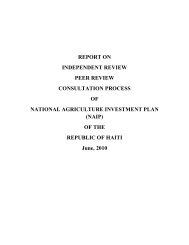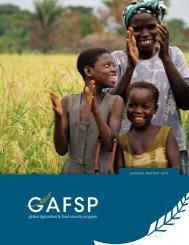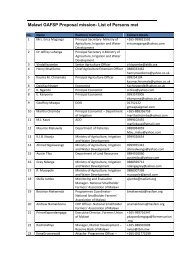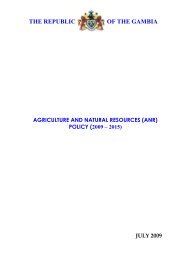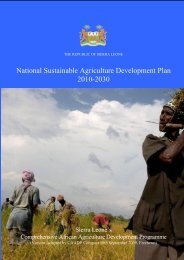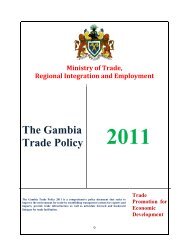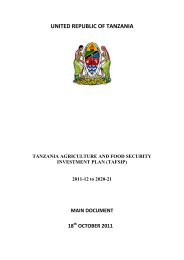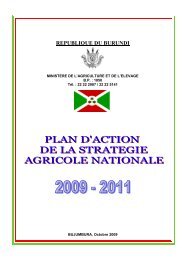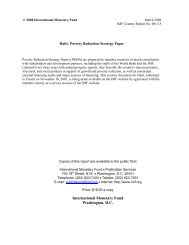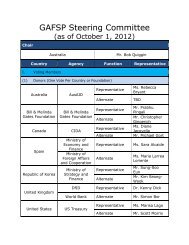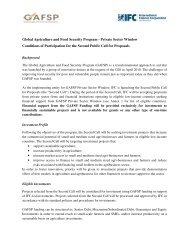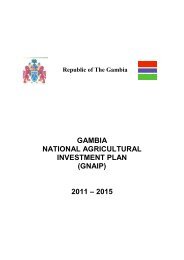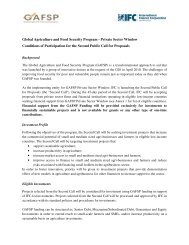World Bank Project Appraisal Document - GAFSP
World Bank Project Appraisal Document - GAFSP
World Bank Project Appraisal Document - GAFSP
Create successful ePaper yourself
Turn your PDF publications into a flip-book with our unique Google optimized e-Paper software.
water losses; improved irrigation distribution; reduced seepage losses from the main canals and<br />
reduced over-supply of irrigation water. Further, longer-term benefits include: a lower water table,<br />
lower risk of salinization, and less stagnant water in the villages with fewer consequent health<br />
problems.<br />
61. Triggered WB OPs. The project will trigger OP 4.01 as it involves activities with some<br />
environmental and social impacts. As the project area includes an irrigation and drainage network that<br />
draws water from tributary of the Amu Darya River and then discharges water back into the river and<br />
thence to the Aral Sea, it also triggers <strong>World</strong> <strong>Bank</strong> OP 7.50 on International Waterways. The proposed<br />
investments for the public works component are not expected to change the volume of<br />
extraction/discharge water or quality of water of the relevant rivers, but rather will lead to more<br />
efficient irrigation and drainage. As an exemption was obtained for notification requirement under OP<br />
7.50 on International Waterways in the original project, an equivalent exemption has been obtained for<br />
the repeater project on the ground that it has the same design and so a similar impact on international<br />
waterways.<br />
62. OP 4.09 on Pest Management is not triggered as the project does not require the purchase<br />
and/or use of pesticides, and based on previous experience in the region, the improved irrigation<br />
infrastructure will not lead to changes in the crops production which would require usage of more<br />
pesticides. The main crop will remain cotton with a limited application of pesticides due to their high<br />
costs. However, the project in view of longer term considerations and changes in demand and supply<br />
trends will allocate resources within its public outreach campaign to carry out information<br />
dissemination activities in support to Integrated Pest Management in the project area. The project will<br />
not trigger OPs on Forests, Physical and Cultural Resources, or Natural Habitats as all activities will<br />
be implemented within the existing irrigation areas. Experience from the original project also shows<br />
that there will be no need to cut fruit trees belonging to private farmers.<br />
63. <strong>Project</strong> environmental category and measures to address potential environmental and social<br />
impacts. The project qualifies as Category B.<br />
64. A Generic Environmental Management Plan (GEMP) was prepared and used for the original<br />
project as the on-farm irrigation and drainage rehabilitation activities were similar in all selected<br />
districts. This GEMP was updated and will be used for the repeater project. Based on this updated<br />
GEMP the Recipient will prepare site-specific Environmental Management Plans (EMPs) for each<br />
selected irrigation scheme, as well as for pumping stations and Kulyab city flood channel<br />
rehabilitation, which will be publicly disclosed and consulted in participating districts. These EMPs<br />
will be used during the project implementation.<br />
65. <strong>Bank</strong> supervision missions in May and November, 2011 showed that the implementation of<br />
environmental safeguards for the original project was satisfactory. As required, the PMU and its<br />
regional branch conducted regular site inspections prior to and during rehabilitation activities to ensure<br />
compliance with contract conditions and the EMPs. The PMU included environmental clauses in the<br />
contracts for contractors, which were monitored for compliance during the civil works. The original<br />
project also hired a specialized NGO to provide environmental training and disseminate information.<br />
The regional branch conducted regular site visits to verify that appropriate environmental preventive<br />
actions and/or mitigation measures were implemented.<br />
15



